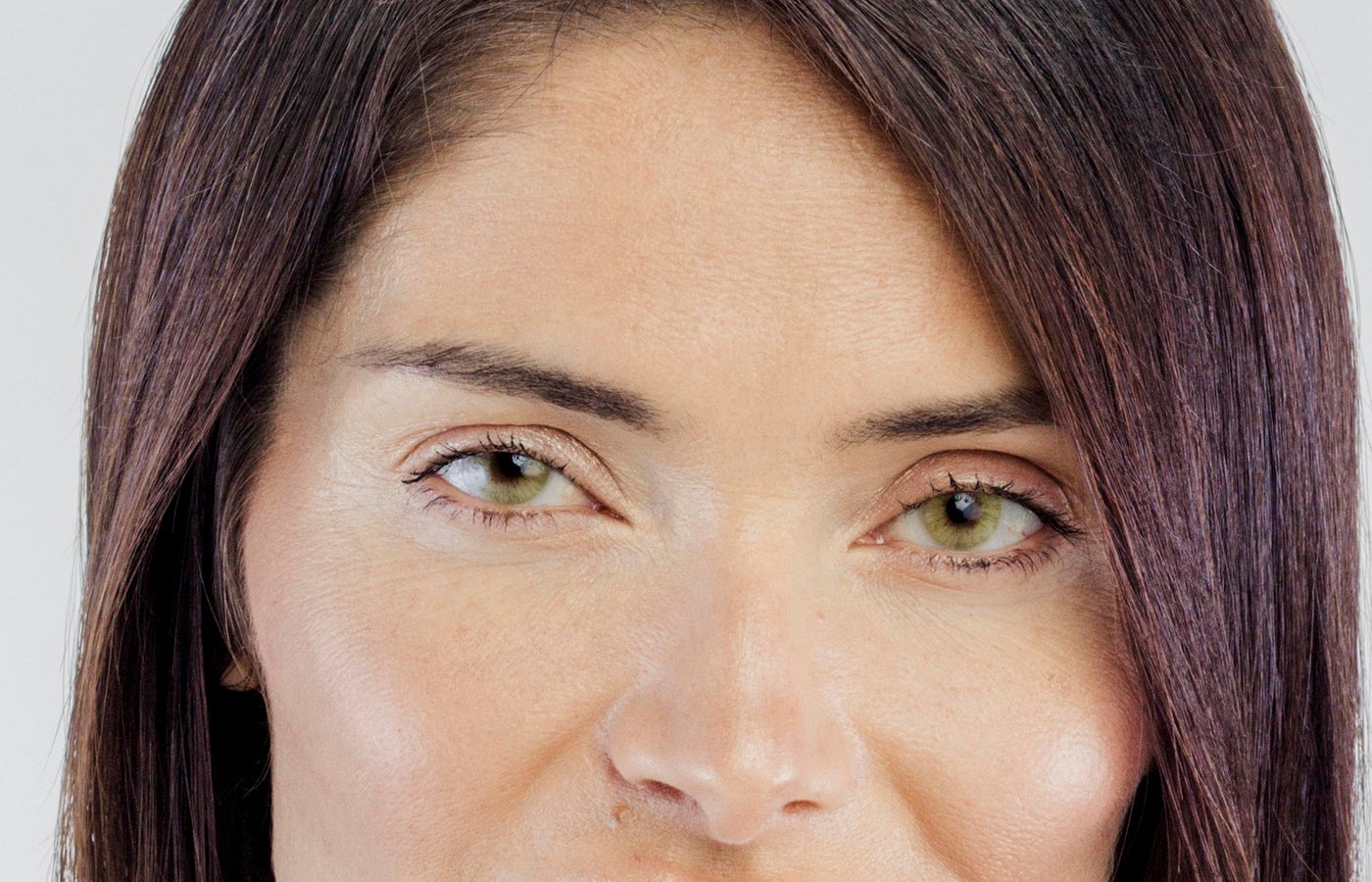Dysport (aka abobotulinumtoxinA) is an injectable neuromodulator that smooths fine lines and wrinkles for up to five months. It’s FDA-approved to treat moderate to severe frown lines, also called glabellar lines or “11s,” between the eyebrows.
It’s also used off-label to smooth other expression lines, like crow’s-feet and forehead creases. According to Dr. Young R. Cho, a Houston, Texas-based plastic surgeon who trains other Dysport injectors for Galderma (its manufacturer), other common treatment areas include:
- armpits and palms, to reduce excessive sweating (hyperhidrosis)
- platysmal bands, to smooth the neck
- masseter muscles, to treat bruxism (teeth grinding) or narrow the width of the face
- bunny lines on the bridge of the nose
- the depressor muscles of the outer lip, to raise the corners of the lip
- the depressor muscle of the nose, to raise the tip
- the mentalis muscle, to smooth the dimples on the chin
- the upper lip, to correct a gummy smile
- elsewhere on the body, to treat medical conditions due to severe muscle spasticity, including vaginismus (with a 75% success rate according to one study)
Dysport is a form of botulinum toxin type A, so it’s similar to Botox, Xeomin, and Jeuveau. Like its competitors, Dysport works by temporarily blocking the communication between nerves and muscles, to stop injected facial muscles from contracting and wrinkling the overlying skin. The process of blocking muscle contractions doesn't damage skin or muscle, but it gets rid of crow's feet, frown lines, and other creases that appear when you make facial expressions.
Beyond smoothing existing wrinkles, the treatment can also be used preventively, to minimize muscle movement and prevent future wrinkles and forehead lines.
Some doctors on RealSelf say that Dysport tends to spread out a bit more than other toxins, but these observations aren’t supported by definitive data, and various factors (including the dose and dilution) can influence the way a toxin diffuses and behaves.
Pros
- Injections are quick (10 to 20 minutes) and have practically no downtime, so they’re easy to fit into your workday.
- For some people, Dysport may kick in faster than other injectable neurotoxins.
- Dysport may create a more natural look than other neuromodulators.
- “Many people report that it lasts longer than other neuromodulators," says Dr. Cho, and recent studies by Galderma show that Dysport may last up to five months.
- It's a temporary fix, so if you don’t like the results, you’re not stuck with them—they’ll gradually disappear within a few months.
Cons
- Results aren’t permanent. If you want to maintain the effects, you’ll need about three treatments a year.
- Needle-phobes might be nervous about getting a series of shallow injections. “The good part is that the needles are typically amongst the smallest available,” says Dr. Cho
- As with any injection, there are potential risks, such as pain, bleeding, bruising, redness, swelling, tenderness, and infection—but all of these side effects should be mild or rare.
RealSelf Tip: The so-called complexing proteins in Dysport (Botox and Jeuveau, too) are thought to contribute to possible drug resistance with continued use. It’s an exceedingly rare problem, but some injectors find that switching to Xeomin—the only “naked protein” on the market—solves it.
- Average Cost:
- $455
- Range:
- $220 - $850
The amount you spend will depend on your provider’s practice location, their credentials, the number of areas injected, how many units are injected in each area, and a few other key factors.
“Remember that dose and duration correlate with one another,” says Dr. Cho. “So while it is easy to design a cheaper treatment price, it might be because of lower doses, which may lead to a shorter duration of results.”
You can finance your treatment with CareCredit.
The Dysport photos in our gallery have been shared by the provider who performed the procedure, with the patient's consent.
Dysport is FDA approved and considered safe, in the hands of an experienced injector. As with any injections, bruising can occur. You can minimize your risk by avoiding blood thinners (that aren’t medically necessary) for a week before your procedure. This includes alcohol, fish oil and vitamin E supplements, and nonsteroidal anti-inflammatory drugs (NSAIDs), like aspirin and Advil. If you do develop a headache post-shot, ibuprofen or acetaminophen is generally safe to take.
Neuromodulators like Dysport are contraindicated in people with myasthenia gravis (MG), a neurological condition in which antibodies destroy the communication between nerves and muscle, resulting in weakness of the skeletal muscles.
Because both myasthenia gravis and neuromodulators affect the strength of muscles, the combination can create an over-exaggerated and prolonged result. If you have MG, ask your provider about alternative treatments like microneedling with platelet-rich plasma (PRP), dermal fillers, and laser resurfacing.
According to the manufacturer, the most common side effects of Dysport include bruising at the injection site, upper respiratory infections, headaches, a sore throat, injection-site pain, eyelid swelling, and nausea.
“Less commonly seen are drooping of the brow and upper eyelid, which are temporary and resolve as the product dissipates,” says Dr. Christopher T. Maloney Jr., a plastic surgeon in Tucson. A droopy eyelid can be improved with over-the-counter Naphcon A eye drops, but they shouldn’t be used for more than 4-5 days.
“Ensuring that your provider is well trained in anatomy and how to read the dynamic changes in muscle with expression is paramount to optimal results and avoiding complications,” Dr. Cho underscores.
Dysport may trigger an allergic reaction for some people, since it contains a protein found in cow’s milk. (Botox and Xeomin don’t contain cow's milk protein.) As doctors on RealSelf have pointed out, this is not the same thing as lactose intolerance. If you have a cow’s milk allergy, talk to your doctor before considering Dysport.
Although very rare, the most serious side effects of botulinum toxin injections arise from the possibility of it spreading beyond the injection site and triggering symptoms like muscle weakness or spasms; double or blurred vision; and trouble speaking, swallowing, or breathing. Tell your doctor right away if you experience any unusual symptoms after your injections.
It’s important to work with a board-certified physician, physician’s assistant, nurse, or another experienced healthcare provider with a deep working knowledge of facial anatomy, to help ensure you receive appropriately placed injections and natural-looking results.
Related: Injectable Bruises? Been There. Here’s How to Handle Them Without Hiding Out.
Your injector will cleanse the treatment area and may offer to apply a numbing cream (though most people find they don’t need it).
Then they'll use a tiny needle to inject small amounts of Dysport into the muscles just beneath your skin, to relax them.
You’ll probably feel pinching but no pain during the injections. Your doctor may ask you to smile, frown, raise your eyebrows, crinkle your nose, or make other expressions to help identify the exact spots that need addressing. The entire treatment should take 10 to 20 minutes, depending on how many areas you’re having treated.
You’ll likely have some mild redness or swelling at the injection sites. Some people also have light bruising for up to a week. Otherwise, you’ll be able to go about your normal activities.
Headaches, which are more common for first-timers, should go away within a few days and can be treated with ibuprofen or acetaminophen.
Your doctor may recommend avoiding exercise or lying flat for a few hours post-treatment, to limit the risk of the drug spreading and creating unwanted effects. For the same reason, don’t rub the injection sites.
It can take about a week for Dysport to take effect, depending on where you were injected and how many units you received.
A typical injection between the eyes is usually around 50 units. With this dosage, results can be visible anywhere from 2 to 14 days after injection, according to doctors on RealSelf.
According to New York City plastic surgeon Dr. Lara Devgan, “Certain providers report anecdotal trends, as in Dysport and Jeuveau taking effect a little earlier or Xeomin allowing a bit more natural movement. But there’s not a statistically significant difference in onset between toxins."
“The effects of Dysport wear off gradually over about four to six months,” says Dr. Weiner. To maintain results, “I usually tell people to come in two to three times a year,” says Dr. Jennifer Reichel, a Seattle-area dermatologist.
While all neuromodulators currently approved for cosmetic use in the U.S. are made from botulinum toxin type A, each brand behaves a little differently due to subtle variations in overall formulation. Some doctors find that Dysport tends to “stick around a little longer,” as Palo Alto, California, plastic surgeon Dr. David Boudreault notes in a RealSelf Q&A.
If your injection wears off within a month, consider asking your doctor for a larger dose.
- Botox and Dysport are both botulinum toxin type A neuromodulators. Both products are injected in similar ways, with no downtime afterward. They also carry similar risks. Dysport may work faster than Botox injections; results are sometimes visible within 48 hours, while Botox may take up to a week for results to show, according to doctors on RealSelf.
- Jeuveau is another type of neuromodulator that relaxes or paralyzes the nerves that tell muscles to flex. By keeping muscles from making certain repeated movements, Jeuveau helps prevent new lines from forming and softens those that are already there. The botulinum toxin A, prabotulinumtoxinA, found in Jeuveau has similar risks and side effects and produces similar results, but the proteins in Jeuveau (and Botox) are considered more pure.
Related: What’s the Difference Between Botox, Dysport, Xeomin, and Jeuveau?
- Xeomin, also a botulinum toxin type A neuromodulator, is another injectable approved by the FDA to treat frown lines, but it’s also used off-label to treat other types of facial wrinkles. Xeomin is unique in that it doesn’t contain additives or preservatives, which decreases the chances of allergic reactions. In some rare cases, continued use of botulinum toxin type A neuromodulators has contributed to possible resistance against certain drugs. The proteins responsible for this reaction are not found in Xeomin.
Yes, you can combine injectables to personalize your treatment with neuromodulators like Dysport. Doctors often refer to this combo as a "liquid lift," explains Dr. Hooman Khorasani, a dermatologic surgeon in New York City. "Neuromodulators can relax frown lines and hyaluronic acid injectables [such as Juvéderm and Restylane] to lift the crease left behind."
Studies even show that the results of hyaluronic acid injectables last longer when used in tandem with neuromodulators.
That said, you may get better results if you don’t have all your injectables at once. “I recommend staging the procedures if you are treating the same area, to limit the spread of Dysport into unintended muscles,” says Dr. Cho. “For example, treating the frown lines with Dysport for the dynamic lines (with expression) and static lines (without expression) with a dermal filler would be best done in two separate procedures.
Most providers also recommend waiting to have microneedling, if you're having Dysport. "The thought is that it takes two weeks maximum for any neurotoxin to completely set in," says Dr. Christopher Balgobin, a physician in Burnsville, Minnesota. "We also don't want the microneedling to possibly disrupt the Dysport placement."






